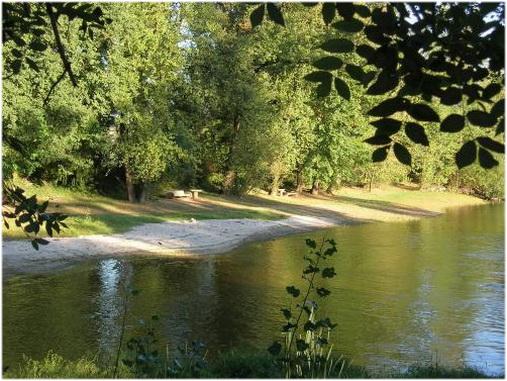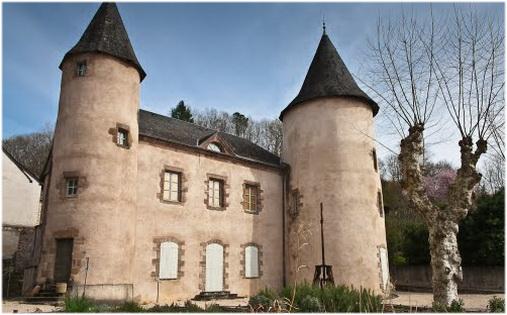Allassac, Corrèze, France
Allassac, whose inhabitants are called the Allassacois and Allassacoises, is a commune in the Corrèze department, located in the Aquitaine-Limousin-Poitou-Charentes region of France. It is also located in the Brive basin, and is irrigated by three main rivers in the north-south direction: the Vézère, its tributary the Loyre, and the Clan, a sub-tributary of the Corrèze. The town is crossed by the line from Les Aubrais - Orléans to Montauban-Ville-Bourbon and is located at the intersection of the departmental roads 9, 25, 34 and 134, in orthodromic distances, six kilometres east of Objat and twelve kilometres north-northwest of Brive-la-Gaillarde.
TOPONYMY AND HISTORY
The name of the commune is said to derive from the Gallo-Roman word Alaciacus (the domain ofAlacius). The first mention of the form Allassac is transcribed in the testament ofAredius (Saint Yrieix). It was called Alaciaco in 947. Historically, the village is identified asAlassac on the Grand Atlas of the Kingdom of France drawn up by Johannes Blaeu in the 17th century and then on the Cassini map of France between 1756 and 1789. Allassat is then found at the beginning of the French Revolution before the definitive appearance of the present name in 1801.
HISTORY
The scrapers and lithic points found on the site show that the site of La Roche has been inhabited since the Mesolithic period. Occupied by the Romans, Allassac already had several slate quarries which allowed the town to develop rapidly.
In the Middle Ages, and more precisely in 572, Saint Yrieix and his mother donated a farm and forges to the village, which was then part of the Yssandon country. In the Carolingian period, there was already a fortified complex with a church and a dwelling belonging to the abbots of Limoges, as well as a lordly dwelling.
In 864 the relics of the Holy Innocents were brought to Allassac to protect them from the Norman invaders. The village then became a seigneury of the abbey of Saint-Martial de Limoges. It then became a co-seigniory belonging, among others, to the Roffignac family, known as the "first Christians of Limousin". In the 14th century, the town was given a second wall with 17 towers, 8 gates and 6 castles. The bishop fought to keep his territory. In 1569, Henri d'Anjou spent a few days there with his armies. The number of noble houses with turrets increased and in 1580, Allassac was the fourth largest town in the Bas Limousin (now Corrèze). In 1790, it was briefly the chief town of the canton before giving way to Donzenac in 1801.
In 1870 the population was 4,200 and slate mining had been an important industry for over a century. The farmer was also a slate quarryman, but the phylloxera epidemic put an end to this double economy. The farmer will then have to turn to fruit and tobacco growing while developing the slate exploitation, the outlets being made towards the Paris region thanks to the train.
HERITAGE
The monuments
The church of Saint Jean-Baptiste The church of Saint Jean-Baptiste : its construction dates from the 12th to the 14th century, its bell tower was fortified in the 14th century during the Hundred Years War. It has a remarkable baroque furniture composed of three altarpieces and a pulpit. The central altarpiece (1679) is dedicated to the "Sacred Heart of Jesus". The fact that it presents Christ showing his Sacred Heart on one side makes it exceptional, this devotion being activated only four years before the creation of the altarpiece, following the apparition of Christ to Marguerite-Marie Alacoque in Paray le Monial in 1675. It is classified as a historical monument.
The chapel of Saint-Nicolas de Tolentine It was built in 1894, in the village of Brochat.
The Sainte-Marguerite chapel The chapel of Sainte-Marguerite: it is a robust chapel which was built from the 13th to the 18th century, in red sandstone, in the village of La Chapelle.
The Saint-Ferréol chapel The chapel of Saint-Ferréol: probably dating from the 17th or 18th century, an integral part of the cemetery, in the village of Chartroulle.
The Saint-Roch chapel The chapel of Saint-Roch: dating from the 16th and 19th centuries, in the village of Gauch.
The Saint-Laurent chapel This is a tiny chapel dating from the 13th and 8th centuries, in the village of Saint-Laurent.
The César tower Dating from the 12th century, it is the only vestige of the fortified enclosure. With a height of 30 metres, it is made of slate and gneiss. The machicolations were added in the 15th century. It is one of the rare round towers of the Middle Ages in Limousin. It is listed as a historical monument.
The manor of the Towers The Manoir des Tours: dating from the 15th and 16th centuries, it houses a collection of 600 Roman and medieval weapons and armour as well as a weapons forge, "La Bombarde", belonging to the last active cutter in France. It is listed as a historical monument.
The castle of Lasteyrie This residence is a 19th century noble house.
The gothic bridge This is a bridge with spouts of the Salient, dating from the 16th century, classified as a historic monument in 1969.
The places
The gorges and waterfalls of Clan
The site of La Roche La Roche site: this is where rocks from the Mesolithic era are found. It has an orientation table.
Related articles
30 (great) ideas for your next hikes in France

Overseas: the islands of France
What are the 20 sunniest cities in France?
Discover the 20 hottest cities in France

What to eat in France: typical dishes, tips and curiosities about French cuisine

Urbex: discovering abandoned places across France and Europe
The ranking of the most expensive cities in France in 2024

Auchel, Nord-Pas-de-Calais-Picardie, France


